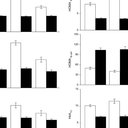Hypoglycemic and hypolipidemic effects of an aqueous extract of Chamaerops humilis leaves in obese, hyperglycemic and hyperlipidemic Meriones shawi rats.
Açar sözlər
Mücərrəd
BACKGROUND
An aqueous concoction made from the leaves of Chamaerops humilis (L.) (dwarf fan palm), is used in the Moroccan traditional medicine for the treatment of diabetes, as well as a number of other diseases. The aim of the study was to experimentally validate the use of C. humilis in the folk treatment of diabetes as well as to determine if the aqueous leaf extract of this plant has hypolipidemic properties in an animal model of obesity, hyperglycemia and hyperlipidemia. The animal model consisted of experimentally induced obesity, hyperglycemia and hyperlidemia (OHH) in Meriones shawi rats. In the acute study, OHH M. shawi rats (n = 8) were given a single oral dose (10 mg/kg) of an aqueous extract of C. Humilis leaves (plant-extract); taurine (8 mg/kg) was used as the positive control. Plasma glucose levels were determined at 2-, 4- and 6-hr after the dose. In the sub-chronic study, groups of OHH rats (n = 8 for each group) were given daily oral doses of the plant-extract and taurine (at the above doses) for 30 days. Body weight (BW), plasma glucose, total cholesterol and triglycerides were measured at 15 and 30 days of dosing. The M. shawi rats developed OHH when maintained on a hypercaloric diet and forced physical inactivity for 90 days. A single oral dose of the plant-extract decreased plasma glucose levels with the maximum effect occurring at 4-hr after the dose (6.88 +/- 1.38 mmol/L compared to baseline 12.04 +/- 0.94 mmol/L; P<0.01). Taurine also decreased plasma glucose (from 12.26 +/- 1.27 mmol/L to 9.15 +/- 1.27 mmol/L; P<0.05); water treated control group did not show any effect. In normal M. shawi (normal) rats, none of the treatments had significant effect on glucose levels. In the sub-chronic study, daily oral administration of the plant-extract or taurine for 30 days to the OHH rats resulted in a significant decrease in BW (from 241 +/- 8 g to 165 +/- 11 g; P<0.001 for the extract, and from 221 +/- 13 g to 189 +/- 11 g; P<0.05 for taurine); water treated control rats showed no effect. In normal rats, administration of the plant-extract or taurine for 30 days resulted in an insignificant decrease in BW, while water administration caused a small (normal) increase in the weight. Plasma glucose levels of the OHH rats decreased significantly with daily dosing with the plant-extract [from baseline 12.04 +/- 0.94 mmol/L to 6.10 +/- 0.27 mmol/L (P<0.05) after 15 days, and to 4.84 +/- 0.22 mmol/L (P<0.001) after 30 days]. Taurine was less effective (P<0.05), while water treated control group did not show any effect. In the normal rats, administration of the plant-extract or taurine for 30 days resulted in a small decrease in glycemia. Administration of plant-extract caused a significant decrease in plasma levels of total cholesterol [from baseline of 3.46 +/- 0.21 mmol/L to 1.05 +/- 0.06 mmol/L (p<0.01) after 15 days and to 0.62 +/- 0.02 mmol/L (p<0.001)] after 30 days, and triglycerides [from baseline of 1.15 +/- 0.17 mmol/L to 0.47 +/- 0.04 mmol/L (p<0.001) after 15 days and to 0.37 +/- 0.03 mmol/L (p<0.001) after 30 days]. Taurine was less effective, while water treated control group did not show any effect. There was no effect of these treatments on lipid levels in normal rats. The results of this study validate the traditional use of the leaves of C. humilis in the treatment of diabetes in Morocco. Since, the aqueous leaf extract also decreased total cholesterol and triglycerides, the plant may also be useful in the management of secondary complications of diabetes (dyslipidemia). Furthermore, the plant may become a good source of antidiabetic medication.


